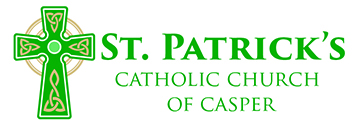Article taken from “The Saint Patrick’s Story,” written by Charlotte M. Babcock
The site of St. Patrick’s Church and school was acquired in 1955 by Monsignor Thomas F. O’Reilly who was the long-time pastor of St. Anthony’s Church and unquestionably the mover and doer of things Catholic in Casper, Wyoming. Casper was growing rapidly; moving and building eastward. The continued growth and the increase in the number of Catholic families clearly necessitated the establishment of the new church.
The boundaries this new parish would encompass were far reaching: touching the Natrona-Converse county line on the east; Elk Street (approximate) on the west; eleven and one-half miles to the north; and twelve miles to the south. Within these boundaries lay 860 square miles.
Monsignor O’Reilly, who acted as project administrator during the construction, immediately put into motion the machinery of creation and architects Goodrich and Wilking drew the plans for what was to be the largest Catholic church building in the state of Wyoming.
Ground was broken in October 1961. The church was constructed in a modified, modern Romanesque design in the shape of a cross, or cruciform – a traditional design for Catholic churches.
Botticino marble was used in both the main and side altars as well as the baptismal font. The altars were designed and executed by Ecclesiastical Arts, Ltd. of Dallas, Texas. They were quarried and worked in Pietro Santa, Italy. All three altars contain relics of martys of the church – traditional in the construction of altars used for celebration of the Holy Sacrifice. A sepulchre in the main altar contains a relic of St. Patrick from his burial place in Downpatrick, County Down, Ireland.
The tabernacle, sanctuary, and Baptistry gates were fashioned in bronze and were made in Holland. According to the Casper Star-Tribune of Sunday, November 25, 1962, the Baptistry, which was connected to the church on the south side by a brick archway, was the subject of much comment in the community. It was designed with seven sides to symbolize the seven sacraments of the church. the north entranceway of the church also elicited considerable comment as the fifty foot bell tower dominated the area which was mostly residential at that time.
The Stations of the Cross and the other wood carvings in the church were created by German artists in Oberammergau, Germany. Because the statues and the Stations of the Cross did not arrive in time for the dedication, Ecclesiastical Arts, Ltd. kindly supplied substitutions.
The magnificent stained glass windows – fifty-seven, in all – were made to specification in Cologne, Germany by Boltz and Meisen and furnished by Ecclesiastical Arts, Ltd. One of the windows, located in the south transept, shows Monsignor O’Reilly giving communion to three children at the feet of Pope Pius X, who was known as the “Children’s Pope”. The stained glass likeness was a complete surprise to Msgr. O’Reilly, who learned of it just shortly before the church was completed. Jan Wilking, the principal architect, sent a photography of Monsignor to Germany where it was reproduced in the glass. Another window in the north transept of the church has a likeness of Bishop Newell. He is shown with five other prelates of the church. Above and behind is Pope John XXIII. This window commemorates the Ecumenical Council called by him. The round window in the choir loft is a likeness of St. Patrick that looks remarkably like the statue of St. Patrick in the altar area of the church. The soaring eye-catching panels that flank the front doors of the church depict a number of eucharistic symbols as well as two sets of initials which the viewer should have no trouble deciphering – TFO and JW. These stone panels, carved in Italy, were delayed in arriving, due to the severe arctic winter that shut down operation of the Italian quarries.
The school, to the south of the church, was built with six classrooms, gymnasium with stage, kitchen, custodian’s quarters, and office area. It was designed to permit easy expansion of two additional classrooms on the ground floor and eight more classrooms on a second story if they were needed. There were also plans at the time for a rectory and a convent, but those plans were subsequently met by the purchase of two homes close to the church. A home at 425 South Illinois became the rectory and its back door opened onto the back parking lot of the church which was accessible by a flight of steps. The design of the church grounds allowed a total of 197 cars to be parked in front and back.
And the initial investment in the church, the school, and the 3.2 acres of land? More than a half million dollars. By the time the furnishings, the rectory, and the convent were tabulated the value came to more than a million dollars according to Father James F. Power, the church’s first pastor. Father Power noted that the complex had only an $80,000 debt when it opened. That debt was paid off in three short years.
The residence at 2654 East 5th Street which became the convent was not purchased until November, 1967 when the Men’s Club of St. Patrick’s Church purchased it from the J. Wollard family at an initial cost of $17,000.00.
